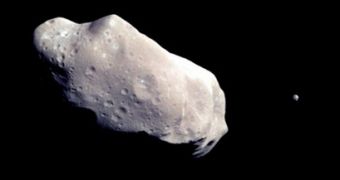2004 MN4, or most popularly known as asteroid 99942 Apophis, is a near Earth asteroid discovered in December 2004. Apophis measures about 400 meters in diameter and upon its discovery, it was given a chance of 2.7 percent that it will hit our planet in 2029. On 19 October 2006, NASA estimated that Apophis had a change of 1 in 45,000 of colliding with Earth on 13 April 2036 and 1 in 12.3 million that it will hit our planet one year later.
13 year-old Nico Marquardt from Potsdam, Germany, revealed this month that the odds have been greatly underestimated by NASA, and Apophis has a chance of 1 in 450 of colliding with Earth, if it were to collide with one of the 40,000 satellites currently in orbit around the Earth. Marquardt's effort to recalculate the risk posed by asteroid Apophis was part of a science competition, and submitted his paper under the title 'Apophis - The Killer Asteroid'.
NASA and the ESA already confirmed that the results obtained by Marquardt are correct. Some of the satellites orbiting Earth travel at velocities of an excess of 3.07 kilometers per second, at altitudes up to 36,000 kilometers. Although Apophis has a low chance to collide with Earth in the near future, it may pass through the vicinity of the planet at distances as low as 32,500 kilometers.
In case the current trajectory of the asteroid is altered during its next fly-by around Earth in 2029, there is a good chance that it will intersect with our planet in 2036. In such a situation, the asteroid burning into Earth's atmosphere would create a sphere of iron and iridium, 320 meters across, having a mass of about 200 billion tons.
It would most likely crash in the Atlantic Ocean and create a tsunami wave that would destroy all coastline and inland areas on both sides of the ocean. The material thrown into Earth atmosphere would create a cloud of dust that would block sunlight for an indefinite amount of time.

 14 DAY TRIAL //
14 DAY TRIAL //